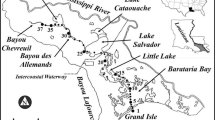a
production in the central, south central, and the south segments of the lagoon. In a system as large and complex as the lagoon, N and P limitations are potentially subject to significant spatial and temporal variability. Total Kjeldahl nitrogen (TN) was higher in the north (1.25 mg/liter) and lower in the south (0.89 mg/liter). The reverse pattern was observed for total P (TP), i.e., lowest in the north (0.03 mg/liter) and highest at the south (0.14 mg/liter) ends of the IRL. This increased P concentration in the SIRL appears to have a significantly large effect on chlorophyll a production compared with the other segments, as indicated by stepwise regression statistics. This relationship can be expressed as follows: South IRL [chlorophyll a] =−8.52 + 162.41 [orthophosphate] + 7.86 [total nitrogen] + 0.38 [turbidity]; R 2= 0.98**.
Similar content being viewed by others
Author information
Authors and Affiliations
Rights and permissions
About this article
Cite this article
Sigua, G., Steward, J. & Tweedale, W. Water-Quality Monitoring and Biological Integrity Assessment in the Indian River Lagoon, Florida: Status, Trends, and Loadings (1988–1994). Environmental Management 25, 199–209 (2000). https://doi.org/10.1007/s002679910016
Issue Date:
DOI: https://doi.org/10.1007/s002679910016




